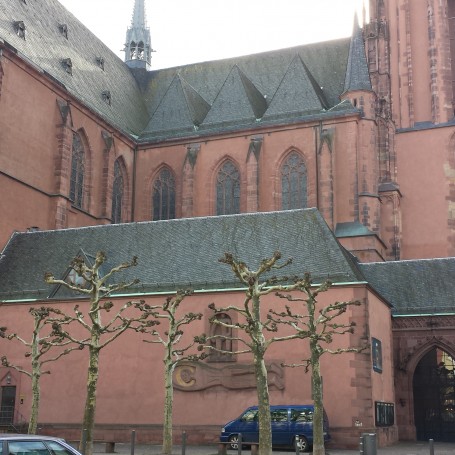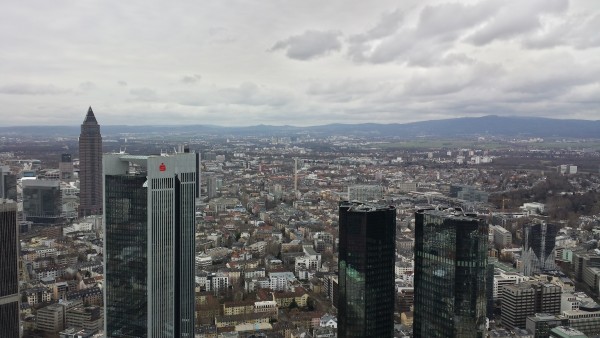
Here’s what I’ve learned about Frankfurt am Main:
- Nobody knows how old the city is; Romans came, hung out and left at some point and didn’t bother to sign the guest book
- It’s named after the Franks, who eventually beat everyone up and declared themselves kings of the land
- The city-state was the site of coronations for the kings and emperors of Germany
- The river which runs through it (hence the name Frankfurt-upon-Main, akin to Newcastle-upon-Tyne), is pronounced “Mine,” not “Mane”
- It’s well-known for banking, business and conferences, which lends itself to the “Bankfurt” moniker
- The tiny downtown and meagre skyline don’t deserve to be compared to Manhattan, so people should stop calling it “Main-hattan”
- Its oldest buildings date from reconstruction after the Second World War (except in the rich part, which was favoured due to selective bombing)
- Only 700,000 people actual live here; the population swells to over 1,000,000 during working hours
I have to say that when I first arrived in Frankfurt am Main, I wasn’t all that impressed with its utilitarian buildings, quiet streets and sparse population. However, it quickly dawned on me that the home of the European Central Bank, while understated, has its finer points.
First, I was interested to find out that it’s the first European city I’ve heard of whose origins are admittedly unknown. I say “admittedly,” because Europeans tend to have a knack with folklore, and a city without known origins usually gets a back story about a pair of founding twin boys who were raised by wolves, for example. Instead, the rather pragmatic inhabitants, while proud of their little banking town, are happy to tell you that they don’t know when the city was established. Honesty is the best policy, I always say.

Next, I came to recognise throughout my tour of the city that it has grown from the ashes of one of the most turbulent times in history, having been rebuilt after its destruction during World War II. At first, I couldn’t help but be taken aback by the utilitarian architecture, circa 1950s-1970s. Moreover, before starting my day-long bus tour, I’d wondered how that period would be broached in the requisite tourist spiel. I was pleasantly surprised to find that the tour guides and recordings didn’t shy away from speaking about the consequences of Germany’s role in the War. We were also introduced to rebuilt historical symbols of German pride, such as the Frankfurter Dom (Frankfurt Cathedral) and the Opera House. I compare this pragmatism to the unfortunate attitude of the White lady at the information booth in Atlanta’s Underground, who whispered “We don’t talk about that here,” when I asked if the popular tourist spot had been named after the Underground Railroad during a visit to Georgia in the late nineties.
In general, I’ve found the people whom I’ve encountered here to be pretty… regular. Furthermore, the people in the service industry actually seem like they like to give service. Pardon my surprise, but I had lived in France for over a year before visiting Germany, and the difference is striking.
When you do come to Frankfurt am Main — I say “when” and not “if” since it’s the main European airport hub — try to spend some time in the city. It’s great for those who enjoy modern city life, with its comprehensive subway, bus and tram system. The river is beautiful, although I’ve always been partial to cities which sit on or are cut through by water.
If you have time, check out the pedestrian mall in the area which served as the main military look-out and jail. Although the jail’s no longer there, you can eat at the restaurant. Its guests will probably be unaware that the area where they’re sitting once housed a class-segregated internment, where delinquent sons of the upper class were kept in comfort while those of the peasants and farmers were housed rudely in the basement.

In addition, if you don’t mind heights, take a trip up to the top of the Main Tower in the centre of the business district. It’s the only vantage point which is open to the public, with a reasonable price of 6,50 euros per adult. The view is stunning, and the elevator literally whisks you up 190m and 54 storeys in a matter of seconds. There’s also a restaurant just below the look-out area.
It’s a really nice place for the open-minded traveller. Frankfurt am Main may not be very nice to look at to the untrained eye, but those keen explorers among you will know to look past its commercial façade and seek out the hidden gems of this tiny metropolis.
